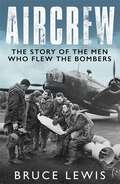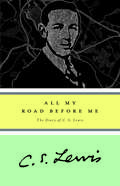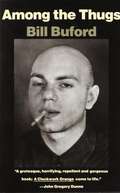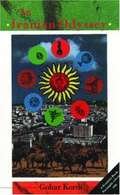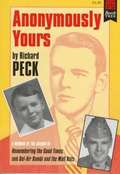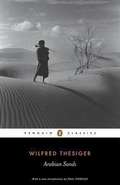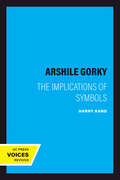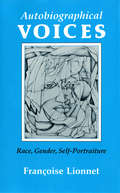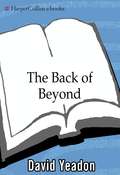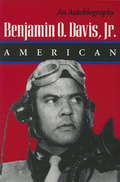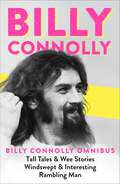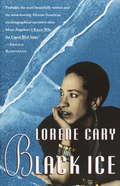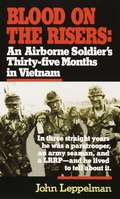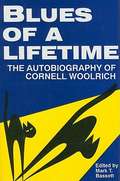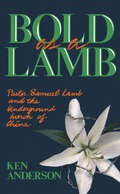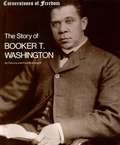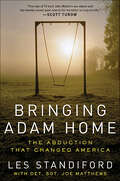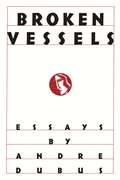- Table View
- List View
Aircrew: Dramatic, first-hand accounts from World War 2 bomber pilots and crew
by Bruce LewisA vivid, first-hand account of the tension and excitement of flying missions over Nazi GermanyThe British and American bomber crews of the Second World War often had to endure the most terrifying conditions. Not for them the glorious, all-or-nothing exhilaration of the Battle of Britain pilots - rather, the slow dwindling of courage as mission followed mission, the long, freezing, ear-shattering journey to the target, the bursting flak, the prowling night fighters. Then, if they were lucky, the long haul home, sometimes nursing a battered, barely flyable machine, often perilously short of fuel.Bruce Lewis flew in thirty-six such raids. In this book he records, in his own words and those of his fellow survivors, the events that made operational flying such a fearful experience.This is a blisteringly honest account of life for the Second World War bombers.
Albert Einstein: Scientist of the 20th Century
by Catherine ReefA biography of physicist Albert Einstein, the man who put forth the general theory of relativity.
Alexander of Macedon, 356-323 B.C.: A Historical Biography
by Peter GreenUntil recently, popular biographers and most scholars viewed Alexander the Great as a genius with a plan, a romantic figure pursuing his vision of a united world. His dream was at times characterized as a benevolent interest in the brotherhood of man, sometimes as a brute interest in the exercise of power. Green, a Cambridge-trained classicist who is also a novelist, portrays Alexander as both a complex personality and a single-minded general, a man capable of such diverse expediencies as patricide or the massacre of civilians. Green describes his Alexander as "not only the most brilliant (and ambitious) field commander in history, but also supremely indifferent to all those administrative excellences and idealistic yearnings foisted upon him by later generations, especially those who found the conqueror, tout court, a little hard upon their liberal sensibilities." This biography begins not with one of the universally known incidents of Alexander's life, but with an account of his father, Philip of Macedonia, whose many-territoried empire was the first on the continent of Europe to have an effectively centralized government and military. What Philip and Macedonia had to offer, Alexander made his own, but Philip and Macedonia also made Alexander form an important context for understanding Alexander himself. Yet his origins and training do not fully explain the man. After he was named hegemon of the Hellenic League, many philosophers came to congratulate Alexander, but one was conspicuous by his absence: Diogenes the Cynic, an ascetic who lived in a clay tub. Piqued and curious, Alexander himself visited the philosopher, who, when asked if there was anything Alexander could do for him, made the famous reply, "Don't stand between me and the sun." Alexander's courtiers jeered, but Alexander silenced them: "If I were not Alexander, I would be Diogenes." This remark was as unexpected in Alexander as it would be in a modern leader. For the general reader, the book, redolent with gritty details and fully aware of Alexander's darker side, offers a gripping tale of Alexander's career. Full backnotes, fourteen maps, and chronological and genealogical tables serve readers with more specialized interests.
All My Road Before Me
by C. S. LewisThe life of the young Lewis was filled with contemplations quite different from those of the mature author. This early diary gives readers a window on the world of his formative years. Edited and with an Introduction by Walter Hooper; Index; photographs.
Among the Thugs
by Bill BufordThey have names like Barmy Bernie, Daft Donald, and Steamin' Sammy. They like lager (in huge quantities), the Queen, football clubs (especially Manchester United), and themselves. Their dislike encompasses the rest of the known universe, and England's soccer thugs express it in ways that range from mere vandalism to riots that terrorize entire cities. Now Bill Buford, editor of the prestigious journal Granta, enters this alternate society and records both its savageries and its sinister allure with the social imagination of a George Orwell and the raw personal engagement of a Hunter Thompson.
An Iranian Odyssey
by Gohar KordiFrom the Book Jacket: Gohar Kordi was born in a small Kurdish village in Iran. At the age of four, she became blind. She writes of her growing up in the country, the family's move to Tehran and her personal struggle to get an education and become the first woman student at the university. Compelling, with a quiet, hypnotic power, An Iranian Odyssey is an autobiography that reveals its belief that adversity can be overcome.
Anonymously Yours
by Richard PeckThe popular author describes how he grew up in Decatur, Illinois, went into teaching, and eventually became a writer, incorporating his earlier experiences into novels intended to reach and change young readers.
Arabian Sands
by Rory Stewart Wilfred ThesigerIn Arabian Sands, William Thesiger charts the time he spent living with the Bedu, including his legendary traverses of the Empty Quarter.
Arshile Gorky: The Implications of Symbols
by Harry RandThis title is part of UC Press's Voices Revived program, which commemorates University of California Press’s mission to seek out and cultivate the brightest minds and give them voice, reach, and impact. Drawing on a backlist dating to 1893, Voices Revived makes high-quality, peer-reviewed scholarship accessible once again using print-on-demand technology. This title was originally published in 1991.This title is part of UC Press's Voices Revived program, which commemorates University of California Press’s mission to seek out and cultivate the brightest minds and give them voice, reach, and impact. Drawing on a backlist dating to 1893, Voices Revived</DIV
Autobiographical Voices: Race, Gender, Self-Portraiture (Reading Women Writing)
by Françoise LionnetAdopting a boldly innovative approach to women’s autobiographical writing, Françoise Lionnet here examines the rhetoric of self-portraiture in works by authors who are bilingual or multilingual or of mixed races or cultures. Autobiographical Voices offers incisive readings of texts by Zora Neale Hurston, Maya Angelou, Marie Cardinal, Maryse Condé, Marie-Thérèse Humbert, Augustine, and Nietzsche.
Back of Beyond
by David YeadonTakes readers to some of the last unspoiled places on Earth, detailing the author's experiences searching for monkeys and turtles in the jungles of Costa Rica, hunting wild boar in Iran, exploring the Sahara, and more.
Benjamin O. Davis, Jr.: American
by Benjamin O. DavisSet against the backdrop of twentieth-century America, against the social fabric of segregation and the broad canvas of foreign war, Benjamin O. Davis, Jr.: American tells a compelling story of personal achievement against formidable odds. Born into an era when potential was measured according to race, Davis was determined to be judged by his character and deeds--to succeed as an American, and not to fail because of color. With twelve million citizens --the black population of the United States--pulling for him, Davis entered West Point in 1932, resolved to become an officer even though official military directives stated that blacks were decidedly inferior, lacking in courage, superstitious, and dominated by moral and character weaknesses. "Silenced" by his peers, for four years spoken to only in the line of duty, David did not falter. He graduated 35th in a class of 276 and requested assignment to the Army Air Corps, then closed to blacks. He went on to lead the 99th Pursuit Squadron and the 332nd Fighter Group--units known today as the Tuskegee Airmen--into air combat over North Africa and Italy during World War II. His performance, and that of his men, enabled the Air Force to integrate years before civilian society confronted segregation. Thereafter, in a distinguished career in the Far East, Europe, and the United States, Davis commanded both black and white units. Davis's story is interwoven with often painful accounts of the discrimination he and his wife, Agatha, endured as a fact of American military and civilian life. Traveling across the country, unable to find food and lodging, they were often forced to make their way nonstop. Once on base, they were denied use of clubs and, in the early days, were never allowed to attend social activities. Though on-base problems were solved by President Truman's integration of the military in 1949, conditions in the civilian community continued, eased but not erased by enactment of President Johnson's legislative program in the 1960s. Overseas, however, where relations were unfettered by racism, the Davises enjoyed numerous friendships within the military and with such foreign dignitaries as President and Madame Chiang Kai-shek. Benjamin O. Davis, Jr., retired in 1970 as a three-star general. His autobiography, capturing the fortitude and spirit with which he and his wife met the pettiness of segregation, bears out Davis's conviction that discrimination--both within the military and in American society--reflects neither this nation's ideals nor the best use of its human resources.
Billy Connolly Omnibus: Tall Tales and Wee Stories/Windswept & Interesting/Rambling Man
by Billy ConnollyTHREE TIMES THE LAUGHS: THE BEST OF BILLY CONNOLLY! 'Our greatest living comedian' Daily Mail'One of stand-up's great naturals. No one told a story better.' Guardian 'Furious, funny and foul mouthed' Sunday TimesTall Tales & Wee StoriesA collection of the very best of Billy's most famous routines including The Last Supper, Jojoba Shampoo, Incontinence Pants and Shouting at Wildebeest. With an introduction and original illustrations by Billy throughout, it is an inspirational, energetic and riotously funny read, and a fitting celebration of our greatest ever comedian.Windswept & Interesting 'It's the first time I've done this. Other people have written about me - or for me - but this time it's just my own life in my own words'Billy's joyfully funny, frank and full autobiography - stuffed full of hard-earned wisdom as well as countless digressions on fishing, farting and the joys of dancing naked. It is an unforgettable, life-affirming story of a true comedy legend.Rambling ManBilly's unconventional travel memoir that criss-crosses the world, encapsulating a lifetime of incredible journeys and hundreds of fascinating encounters - from riding his trike down America's famous Route 66, building an igloo on an iceberg in the Arctic, playing elephant polo (badly) in Nepal and crashing his motorbike (more than once), to eating witchetty grubs in Australia, being serenaded by a penguin in New Zealand, and swapping secrets in a traditional Sweat Lodge ritual in Canada.
Billy Connolly Omnibus: Tall Tales and Wee Stories/Windswept & Interesting/Rambling Man
by Billy ConnollyTHREE TIMES THE LAUGHS: THE BEST OF BILLY CONNOLLY! 'Our greatest living comedian' Daily Mail'One of stand-up's great naturals. No one told a story better.' Guardian 'Furious, funny and foul mouthed' Sunday TimesTall Tales & Wee StoriesA collection of the very best of Billy's most famous routines including The Last Supper, Jojoba Shampoo, Incontinence Pants and Shouting at Wildebeest. With an introduction and original illustrations by Billy throughout, it is an inspirational, energetic and riotously funny read, and a fitting celebration of our greatest ever comedian.Windswept & Interesting 'It's the first time I've done this. Other people have written about me - or for me - but this time it's just my own life in my own words'Billy's joyfully funny, frank and full autobiography - stuffed full of hard-earned wisdom as well as countless digressions on fishing, farting and the joys of dancing naked. It is an unforgettable, life-affirming story of a true comedy legend.Rambling ManBilly's unconventional travel memoir that criss-crosses the world, encapsulating a lifetime of incredible journeys and hundreds of fascinating encounters - from riding his trike down America's famous Route 66, building an igloo on an iceberg in the Arctic, playing elephant polo (badly) in Nepal and crashing his motorbike (more than once), to eating witchetty grubs in Australia, being serenaded by a penguin in New Zealand, and swapping secrets in a traditional Sweat Lodge ritual in Canada.
Black Ice
by Lorene CaryIn 1972 Lorene Cary, a bright, ambitious black teenager from Philadelphia, was transplanted into the formerly all-white, all-male environs of the elite St. Paul's School in New Hampshire, where she became a scholarship student in a "boot camp" for future American leaders. Like any good student, she was determined to succeed. But Cary was also determined to succeed without selling out. This wonderfully frank and perceptive memoir describes the perils and ambiguities of that double role, in which failing calculus and winning a student election could both be interpreted as betrayals of one's skin. Black Ice is also a universally recognizable document of a woman's adolescence; it is, as Houston Baker says, "a journey into selfhood that resonates with sober reflection, intelligent passion, and joyous love."
Blood Memory
by Jane Rosenman Martha GrahamGraham, the extraordinary creative force who ranks with Picasso and Stravinsky, broke traditional molds and ultimately changed the way we look at the world. Blood Memory invites readers to explore her phenomenal life and highlights the unforgettable images that encompass her work. 100 photographs.
Blood on the Risers: An Airborne Soldier's Thirty-five Months in Vietnam
by John LeppelmanFrom Dak To to the Tet Offensive, John Leppelman saw it all. In three tours of duty, he made combat jumps, spent months of fruitless effort looking for the enemy, watched as his budies died because of lousy leadership and lousy weapons. He saw the war as few others did, and lives to tell about the valor and sacrifice that outlived the dead.From the Paperback edition.
Blues of a Lifetime
by Mark T. BassettBlues of a Lifetimeis essential reading for people interested in suspense novelist Cornell Woolrich, author of Rear Window. Woolrich's autobiography includes accounts of his working methods, his family and home, memories of childhood, college experience, and his philosophy of life.
Bo Jackson
by John RolfeA biography of the star athlete who plays both professional baseball and football.
Bold as a Lamb: Pastor Samuel Lamb and the Underground Church of China
by Ken AndersonYou cannot understand China without meeting heroes like Samuel Lamb! In an age when secularism and materialism numb the human spirit, China's amazing Christians demonstrate the power of living faith. In 1950 China's Christians numbered about a million. Today, estimates range between 30 and 70 million! How did this body of believers grow so rapidly under atheism and materialism? Bold as a Lamb is the true story of Pastor Samuel Lamb. Imprisoned for more than twenty years for preaching the Gospel, he became the beloved secret pastor to hundreds of fellow inmates. After his release in 1978, he built a phenomenal "house church" congregation of more than a thousand. Soon, however, he became the special target of those determined to destroy the mushrooming house church movement in China. His church was closed and his ministry tools were confiscated. Yet this man remains undaunted, standing boldly -- and with spiritual grace, against fierce opposition. This is the fascinating, eye-opening account of one of China's best-known pastors, his dauntless congregation, and how they found joy and optimism in the face of relentless persecution.
Booker T. Washington (Cornerstones of Freedom)
by Patricia C. Mckissack Fredrick L. MckissackTraces the life of the African American educator and leader, focusing on his stewardship of Tuskegee Institute.
Born in the Year of Courage
by Emily CroffordIt is the mid-1800s and Manjiro, a young fisherman, is shipwrecked far off the coast of his native Japan. <p><p> At this time in history, Japan is an isolated country that allows its citizens no contact with the rest of the world. Foreigners are called "barbarians"—and none are more despised than Americans. But when Manjiro and his fishing companions are rescued by an American ship, Manjiro makes some startling discoveries about the world of the barbarians—and about his own country. <p><p> His dramatic rescue leads to a series of amazing escapades, and in the end Manjiro travels farther than he ever dreamed he would. Born in the Year of Courage is based on the true story of Manjiro's remarkable life. It is both an exciting adventure tale and a fascinating look at a bygone world.
Breaking Barriers: The Feminist Revolution from Susan B. Anthony to Margaret Sanger to Betty Friedan
by Jules ArcherAn exploration of the women's movement, with biographies of Susan B. Anthony, Margaret Sanger, and Betty Friedan.
Bringing Adam Home: The Abduction That Changed America
by Les Standiford Joe Matthews“[An] account of the decades-long attempt to solve the murder of Adam Walsh . . . as relentlessly suspenseful as anything I’ve ever read.” —Dennis Lehane, author of Small MerciesBefore Adam Walsh there were no faces on milk cartons, no Amber Alerts, no federal databases of crimes against children. The six-year-old’s 1981 abduction and murder in Hollywood, Florida—unsolved for more than a quarter of a century—forever changed America. His parents went on to become fierce advocates for missing children, and his father, John Walsh, served as host of America’s Most Wanted. From New York Times-bestselling author Les Standiford, Bringing Adam Home is a harrowing account of the terrible crime and its dramatic consequences, the emotional story of a father and mother’s efforts to seek justice and resolve the loss of their child, and a compelling portrait of Miami Beach Homicide Detective Joe Matthews, whose unwavering dedication brought the Adam Walsh case to its resolution.“The most significant missing child case since the Lindbergh [kidnapping]. . . . A taut, compelling and often touching book about a long march to justice.” —Scott Turow, author of Presumed Innocent“Compelling.” —Miami Herald“[A] page-turner . . . tough to forget.” —People“The definitive account.” —The Washington Post
Broken Vessels: Essays
by Andre DubusBroken Vessels, Andre Dubus's first collection of essays, was written between 1977 and 1990. During this period, Dubus hit his peak as an essayist, survived an accident that almost destroyed his will to write, and went on to regain and exceed his earlier power as a writer. Reading this book is almost as rich an experience as meeting a fascinating person: you'll learn the best way to scramble eggs, why baseball is a transcendental experience, the risks and rewards of idealistic poverty, and what it's like to see ghosts. Dubus writes as a Catholic, and most of his essays speak explicitly of the sacramental nature of his everyday experiences. Particularly effective are the essays describing Dubus's struggle to recover from a traffic accident that occurred after he stopped to help stranded motorists on a roadside in 1986. "Lights of the Long Night" is among the best of these, containing the kind of writing that makes you close the book immediately, knowing you've seen so deeply into a person's soul that you have to sit with what you've learned and wait for some sense of how to respond before you're entitled to keep turning the pages.
